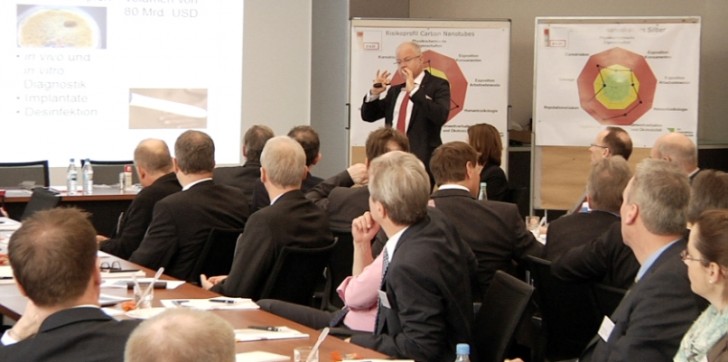New Monitoring System of Nano-Risks

(Cologne / St. Gallen) On the occasion of the nanotechnology liability forum in Cologne, held on the 17th of March, the reinsurance group Gen Re and the Innovation Society, St. Gallen presented a newly developed risk monitoring system of synthetic nanomaterials (NM). The monitoring system is intended to enable the sustainable insurability of nanotechnologies. These possess an enormous growth potential. At the same time major uncertainties concerning potential risks exist for certain nanomaterials.
Nano monitoring with comprehensive risk focus
The system is based on the collection of comprehensive scientific data and can support insurers in assessing and identifying potential nano risks in their portfolio. The risk profiles of key nanomaterials are analysed and evaluated based on nine individual criteria. The materials are divided into risk classes and the risk profiles visualised. The monitoring can be updated constantly or at stipulated intervals upon request, ensuring the most recent data is included in the risk profiles. Gen Re suggests that the monitoring will allow the industry to work more intensively with nanomaterials through a better understanding of their effects on human health and the environment.
Missing data on toxicology and regulatory gaps require long-term monitoring
The new nano monitoring is specifically tailored to insurances and the complex risk-return profile of nanomaterials. It should be noted that some nanomaterials have an increased risk potential. For example, certain nanomaterials (such as certain carbon nanotubes, CNT) have an increased toxicity or may even be carcinogenic. Under inadequate work hygiene conditions, employees that come into contact with free particles, often through inhalation, are potentially at risk.
At the same time, nanomaterials are regulated in many countries under existing laws as conventional chemicals. This means that regulatory gaps may exist. Adverse developments with respect to toxicity and regulation may result in an increase in exposures for liability insurance.
Nanomaterials are widely used in consumer products
Nanomaterials are found in many consumer products. Any harmful effects proven or alleged to be caused by nanomaterials could have enormous loss potential. Despite the generally positive perception of nanotechnologies, consumers remain critical of certain applications. Here, significant reputational risks exist for manufacturers and distributors. Reputational risks – regardless of the actual toxicity of the materials – can result in lost revenue for manufacturers.
Solvency II calls for the exploration of emerging risks
The new insurance supervisory system Solvency II calls for the establishment of a risk management policy that covers all material risks, including emerging risks as part of ORSA (Own Risk and Solvency Assessment).
Insurance companies are required to assess their proprietary situation regarding current and future risks regularly. Insurers should therefore take steps to identify, monitor and assess nano risks in their portfolio on an ongoing basis. In addition, underwriters and risk managers should be appropriately sensitised to nano risks.
The insurance industry should have the objective to actively support nanotechnologies, without losing sight of the hazard potential from an actuarial viewpoint. The risk monitoring that was developed by Gen Re in cooperation with The Innovation Society can provide an excellent basis for insurers.
Further information:
The Innovation Society, St.Gallen
Lerchenfeldstr. 5
9014 St. Gallen
+41 71 278 02 04
Source: Gen Re Cologne / The Innovation Society, St.Gallen
Image Source: Gen Re Cologne/ Finanzplaner TV GmbH
Video: Gen Re Cologne/ Finanzplaner TV GmbH